A Shallow Water Case of Ordovician Marine Red Beds (South China): Evidence from Sedimentary Structures and Response to the Kwangsian Orogeny
Abstract
1. Introduction
2. Study Area
3. Research Methods
4. Results
4.1. Petrological and Petrographical Characteristics of OMRBs
4.1.1. Mineral Composition
Non-Red Beds (Honghuayuan Formation)
Red Beds (Dawan and Kuniutan Formations)
4.1.2. Elemental Composition
4.2. Subdivision of Sedimentary Structures
4.2.1. “Nodular” Structures
- a.
- Brecciated Structure (I-a)
- b.
- Patchy Structure (I-b)
- c.
- Brecciated–Patchy Structure (I-c)
- d.
- Irregular Argillaceous Band Structure (I-d)
- e.
- Argillaceous band–Patchy Structure (I-e)
- f.
- Mud shell Structure (I-f)
4.2.2. “Cracked” Structures
- a.
- Brain-Wrinkle Structure (II-a)
- b.
- Fish-Scale Structure (II-b)
- c.
- Grid Structure (II-c)
- d.
- Lens-shaped Structure (II-d)
5. Discussion
5.1. Reassessment of Previous Sedimentary Structure Genesis
5.1.1. “Nodular” Structure Formation Assessment
5.1.2. “Cracked” Structure Formation Assessment
5.2. Interpretation of Sedimentary Structure Genesis in This Study
5.2.1. Genesis of Patches
Coloring Mechanism
Sources of Coloring Elements
Differences in Patches
5.2.2. Genesis of Brecciated Structures
5.2.3. Genesis of Argillaceous Bands
Syndepositional Argillaceous Bands
Modified Argillaceous Bands
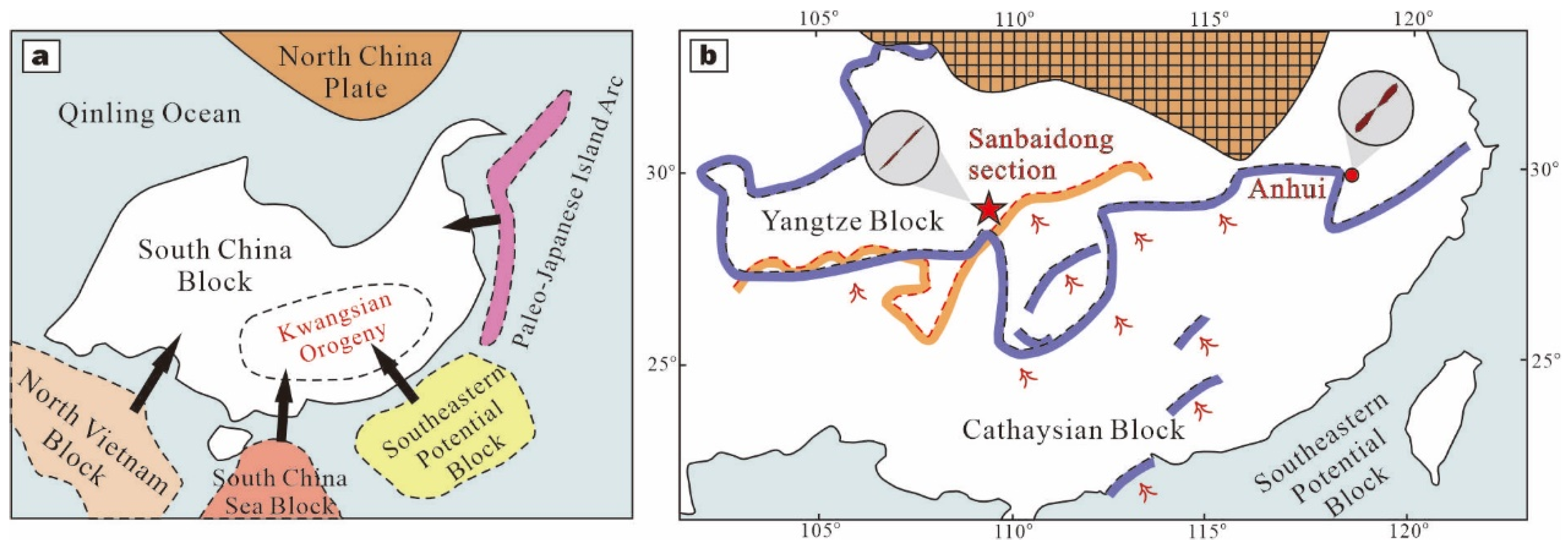
5.2.4. Causes and Statistics of Each Subtype
5.3. Linking to Sedimentary Environments
6. Conclusions
- (1)
- A new genetic classification scheme is proposed, subdividing the sedimentary structures into ten distinct subtypes. These subtypes are categorized into three key genetic end-members: the breccia, patch, and argillaceous band end-members.
- (2)
- The genesis of these structures is elucidated through the three end-members. The breccia end-member indicates deposition in a shallow-water, high-energy environment. The patch end-member reflects control by syndepositional redox conditions and the later influence of reducing fluids. The argillaceous bands have a dual origin, forming either under primary depositional conditions or from syndepositional compressive stress.
- (3)
- The development of vertically penetrating argillaceous bands was controlled by syndepositional compressive stress, likely related to NW-directed compression during the early stages of the Kwangsian Orogeny.
Supplementary Materials
Author Contributions
Funding
Data Availability Statement
Acknowledgments
Conflicts of Interest
References
- Turner, P. Continental Red Beds; Elsevier: Amsterdam, The Netherlands, 1980. [Google Scholar]
- Einsele, G. Sedimentary Basins: Evolution, Facies, and Sediment Budget; Springer Verlag: Berlin, Germany, 2000. [Google Scholar]
- Li, S.Z.; Liu, L.J.; Suo, Y.H.; Li, X.Y.; Zhou, J.; Jiang, Z.X.; Guan, H.X.; Sun, G.Z.; Yu, L.; Liu, P.; et al. Carbon Tectonics: A new paradigm for Earth system science. Chin. Sci. Bull. 2023, 68, 309–338. [Google Scholar] [CrossRef]
- Campbell, I.H.; Allen, C.M. Formation of supercontinents linked to increases in atmospheric oxygen. Nat. Geosci. 2008, 1, 554–558. [Google Scholar] [CrossRef]
- Yoshiya, K.; Sawaki, Y.; Hirata, T.; Maruyama, S.; Komiya, T. In-situ iron isotope analysis of pyrites in ~3.7 Ga sedimentary protoliths from the Isua supracrustal belt, southern West Greenland. Chem. Geol. 2015, 401, 126–139. [Google Scholar] [CrossRef]
- Duncan, M.S.; Dasgupta, R. Rise of Earth’s atmospheric oxygen controlled by efficient subduction of organic carbon. Nat. Geosci. 2017, 10, 387–392. [Google Scholar] [CrossRef]
- Huang, J.; Liu, X.; He, Y.; Shen, S.; Hou, Z.; Li, S.; Li, C.; Yao, L.; Huang, J. The oxygen cycle and a habitable Earth. Sci. China Earth Sci. 2021, 64, 511–528. [Google Scholar] [CrossRef]
- Chen, X.Q.; Zhang, L.F. Carbon sequestration, transport, transfer, and degassing: Insights into the deep carbon cycle. Earth Sci. Front. 2023, 30, 313–339. [Google Scholar]
- Hu, X.M.; Robert, W.; Scott Cai, Y.F.; Wang, C.S.; Mihaela, C. Melinte-Dobrinescu. Cretaceous oceanic red beds (CORBs): Different time scales and models of origin. Earth-Sci. Rev. 2012, 115, 217–248. [Google Scholar]
- Zhang, S.C.; Wang, H.J.; Wang, X.M.; Ye, Y.T. The Mesoproterozoic Oxygenation Event. Sci. Sin. (Terrae) 2022, 52, 26–52. [Google Scholar]
- Wang, C.; Hu, X.; Huang, Y.; Scott, R.; Wagreich, M. CretaceanousOceanic Red Beds (CORB): A Window on Global Oceanic/Climatic Change. In Cretaceanous Red Beds: Strategy, Composition, Origins and Paleoceanographic/Paleoclimatic Significance; Hu, X., Wang, C., Scott, R., Wagreich, M., Jansa, L., Eds.; SEPM Special Publication: Tulsa, OK, USA, 2009; Volume 91, pp. 13–33. [Google Scholar]
- Hu, X.M. Distribution, types and origins of phanerozoic marine red beds. Bull. Miner. Petrol. Geochem. 2013, 32, 335–342. [Google Scholar]
- Lajoie, J.; Chagnon, A. Origin of red beds in a Cambrian flysch sequence, Canadian Appalachians, Quebec. Sedimentology 1973, 20, 91–103. [Google Scholar] [CrossRef]
- Turner, P. Diagenetic origin of Cambrian marine red beds: Caerfai Bay Shales, Dyfed, Wales. Sediment. Geol. 1979, 24, 269–281. [Google Scholar] [CrossRef]
- Ziegler, A.; McKerrow, W. Silurian marine red beds. Am. J. Sci. 1975, 275, 31–56. [Google Scholar] [CrossRef]
- Rong, J.Y.; Wang, Y.; Zhang, X.L. Tracking shallow marine red beds through geological time as exemplified by the lower Telychian (Silurian) in the Upper Yangtze Region, South China. Sci. China Ser. D Earth Sci. 2012, 55, 699–713. [Google Scholar] [CrossRef]
- Franke, W.; Paul, J. Pelagic redbeds in the Devonian of Germany—Deposition and diagenesis. Sediment. Geol. 1980, 25, 231–256. [Google Scholar] [CrossRef]
- Arthur, M.A.; Fischer, A.G. Upper Cretaceous–Paleocene magnetic stratigraphy at Gubbio, Italy I. Lithostratigraphy and sedimentology. Geol. Soc. Am. Bull. 1977, 88, 367–389. [Google Scholar] [CrossRef]
- Bourque, P.A.; Boulvain, F. A model for the origin and petrogenesis of the red stromatactis limestone of Paleozoic carbonate mounds. J. Sediment. Res. 1993, 63, 607–619. [Google Scholar] [CrossRef]
- Boulvain, F.; De Ridder, C.; Mamet, B.; Préat, A.; Gillan, D. Iron microbial communities in Belgian Frasnians carbonate mounds. Facies 2001, 44, 47–59. [Google Scholar] [CrossRef]
- Tong, J.; Zhang, J.; Zhao, L. Report on the Lower Triassic of Chaohu, Anhui Province, China. Albertiana 2001, 25, 23–27. [Google Scholar]
- Heydari, E.; Hassanzadeh, J.; Wade, W.; Ghazi, A. Permian–Triassic boundary interval in the Abadeh section of Iran with implications for mass extinction: Part 1—Sedimentology. Palaeogeogr. Palaeoclimatol. Palaeoecol. 2003, 193, 405–423. [Google Scholar] [CrossRef]
- Préat, A.; Morano, S.; Loreau, J.P.; Durlet, C.; Mamet, B. Petrography and biosedimentology of the Rosso Ammonitico Veronese (Middle–Upper Jurassic, north-eastern Italy). Facies 2006, 52, 265–278. [Google Scholar] [CrossRef]
- Van Der Kooij, B.; Immenhauser, A.; Steuber, T.; Hagmaier, M.; Bahamonde, J.R.; Samankassou, E.; Tomé, O.M. Marine red staining of a Pennsylvanian carbonate slope: Environmental and oceanographic significance. J. Sediment. Res. 2007, 77, 1026–1045. [Google Scholar] [CrossRef][Green Version]
- Lin, B.Y.; Ren, J.S.; Li, M.; Wu, Z.J. Late Darriwilian to Early Katian(Ordovician) Marine Red Beds from the Main Blocks in China and Their Tectonic Significance. Acta Geol. Sin. 2018, 92, 2002–2017. [Google Scholar][Green Version]
- Li, M.; Lin, B.Y.; Song, Y.Y. Distribution and Ages of Ordovician and Silurian Marine Red Beds in Tibet. Acta Geosci. Sin. 2019, 40, 428–446. [Google Scholar][Green Version]
- Wu, L.J.; Wang, P.J.; Ye, Q.Z.; Huang, C.; Quan, X.Q.; Wei, H.X.; Li, F.Y. Characteristics of carbon and oxygen isotopic compositions and the palaeoenvironmental significance of Ordovician red carbonate rocks in Xiangxi, Hunan. Acta Geol. Sin. 2023, 97, 1245–1261. [Google Scholar][Green Version]
- Bábek, O.; Kumpan, T.; Li, W.J.; Holá, M.; Šimíček, D.; Kapusta, J. Incipient reddening of Ordovician carbonates: The origin and geochemistry of yellow and pink colouration in limestones. Sediment. Geol. 2022, 440, 106262. [Google Scholar] [CrossRef]
- Wu, L.J.; Zhang, Y.H.; Wang, P.J.; Li, B.; Ye, Q.Z.; Peng, W.H.; Jiang, H.X.; Jiang, J.H.; Wei, H.X.; Li, F.Y. Karst Geoheritage of the Red Stone Forest in the Xiangxi UNESCO Global Geopark: Chromogenic Factors, Microgeomorphology and Dissolution Behaviour. Geoheritage 2024, 16, 18. [Google Scholar] [CrossRef]
- Wu, L.J.; Jiang, H.X.; Chen, W.H.; Peng, W.H. Geodiversity, Geotourism, Geoconservation, and Sustainable Development in Xiangxi UNESCO Global Geopark—A Case Study in Ethnic Minority Areas. Geoheritage 2021, 13, 99. [Google Scholar] [CrossRef]
- Torsvik, T.H.; Paulsen, T.S.; Hughes, N.C.; Myrow, P.M.; Ganerød, M. The Tethyan Himalaya: Palaeogeographical and tectonic constraints from Ordovician palaeomagnetic data. J. Geol. Soc. 2009, 166, 679–687. [Google Scholar] [CrossRef]
- Ouanaimi, H.; Soulaimani, A.; Hoepffner, C.; Michard, A.; Baidder, L. The Atlas-Meseta Red Beds basin (Morocco) and the Lower Ordovician rifting of NW-Gondwana. Bull. Société Géologique Fr. 2016, 187, 155–168. [Google Scholar]
- Wu, L.J.; Chen, W.H.; Rong, Y.B.; Zhang, J.; Huang, C.; Zhu, H.; Meng, Q.X.; Wu, J.W.; Luo, Q.K.; Bai, B.; et al. Development characteristics and research value of red carbonate stone forest in the Xiangxi geopark. Carsologica Sin. 2020, 39, 251–258. [Google Scholar]
- Estrada, S.; Läufer, A.; Eckelmann, K.; Hofmann, M.; Linnemann, U. Continuous Neoproterozoic to Ordovician sedimentation at the East Gondwana margin-Implications from detrital zircons of the Ross Orogen in northern Victoria Land, Antarctica. Gondwana Res. 2016, 37, 426–448. [Google Scholar] [CrossRef]
- Dan, W.; Murphy, J.B.; Tang, G.J.; Zhang, X.Z.; White, W.M.; Wang, Q. Cambrian-Ordovician magmatic flare-up in NE Gondwana: A silicic large igneous province? GSA Bull. 2023, 135, 1618–1632. [Google Scholar] [CrossRef]
- Cao, X.J.; Jiang, F.W.; Chen, Y.Z.; Dong, Y.; Yang, H.B. Geological conditions and evolution model of red karst landscape in the Wulingshan area, China. Carsologica Sin. 2020, 39, 945–951. [Google Scholar]
- Jiang, F.W.; Dong, Y.; Chen, Y.Z.; Yu, N.; Cao, X.J. Characteristics and genesis of red karst in Guizhou section of Youshui river basin. Carsologica Sin. 2020, 39, 937–944. [Google Scholar]
- Scotese. PALEOMAP PaleoAtlas for GPlates and the PaleoData Plotter Program, PALEOMAP Project. 2016. Available online: https://www.earthbyte.org/paleomap-paleoatlas-for-gplates/ (accessed on 28 September 2025).
- Luck, G.R. The Palaeomagnetism of Some Cambrian and Ordovician Sediments from the Northern Territory, Australia. Geophys. J. R. Astron. Soc. 1970, 20, 31–39. [Google Scholar] [CrossRef]
- Glover, J.E. Petrology of the halite-bearing Carribuddy Formation, Canning Basin, Western Australia. J. Geol. Soc. Aust. 1973, 20, 343–358. [Google Scholar] [CrossRef]
- Zerrahn, J.G. Ordovician (Trenton to Richmond) depositional patterns of New York State, and their relation to the Taconic orogeny. GSA Bull. 1978, 89, 1751–1760. [Google Scholar] [CrossRef]
- Perroud, H.; Robardet, M.; Van der Voo, R.; Bonhommet, N.; Paris, F. Revision of the age of magnetization of the Montmartin red beds, Normandy, France. Geophys. J. R. Astron. Soc. 1984, 80, 541–549. [Google Scholar] [CrossRef]
- Ryazantsev, A.; Tolmacheva, T. Ordovician Volcanic and Plutonic Complexes of the Sakmara Allochthon in the Southern Urals. Geotectonics 2016, 50, 553–578. [Google Scholar] [CrossRef]
- Cole, T.; Matthew, R. Paired carbon isotopic analysis of Ordovician bulk carbonate (δ13Ccarb) and organic matter (δ13Corg) spanning the Great Ordovician Biodiversification Event. Palaeogeogr. Palaeoclimatol. Palaeoecol. 2016, 458, 102–117. [Google Scholar]
- Schmitz, B.; Farley, K.A.; Goderis, S.; Heck, P.R.; Bergström, S.M.; Boschi, S.; Claeys, P.; Debaille, V.; Dronov, A.; Van Ginneken, M.; et al. An extraterrestrial trigger for the mid-Ordovician ice age: Dust from the breakup of the L-chondrite parent body. Sci. Adv. 2019, 5, eaax4184. [Google Scholar] [CrossRef]
- Zhang, L.N.; Fan, J.X.; Wang, B.; Zhang, Y.D.; Liu, J.B.; Huang, H.; Chen, Q. Quantitative paleogeographical reconstructions and basin evolution of South China during the Ordovician. Earth-Sci. Rev. 2023, 241, 104400. [Google Scholar] [CrossRef]
- Chen, X.; Qiu, J.Y. The Paleoenvironmental Evolution of the Ordovician in Yichang. J. Stratigr. 1986, 10, 1–15. [Google Scholar]
- Wu, J.W.; Xia, S.F. Notes on the origin of the “Polygonal marking” limestones. J. Nanjing Univ. 1989, 25, 136–141+149. [Google Scholar]
- Shen, J.W. New Observations of the Origin of Baota Limestone in Guizhou and Its Adjacent Regions. Geol. Guizhou 1989, 6, 35–38+22. [Google Scholar]
- Guo, F.S.; Liang, D.X. On The Origin of Nodular Limestone in Yanwashan Formation in Jiangshan, Zhejiang. Mineral. Petrol. 1993, 13, 74–80. [Google Scholar]
- Fang, S.X.; Hou, F.H.; Lan, G.; Deng, M. Genesis of ‘Horseheely Crack’ Texture And Its Hydrocarbon Potential In Middle Ordevician Baota Limestones In Sichuan And Guizhou. Mar. Orig. Pet. Geol. 1994, 1, 36–40. [Google Scholar]
- Wang, Y. Middle Ordovician cracked limestones of polygonal structure in the upper Yangtze River area, south China’s new interpretation of their origin. Chin. J. Geol. 1995, 30, 268–274. [Google Scholar]
- Zhou, C.M.; Xue, Y.S. On Polygonal Reticulate Structure of the Ordovician Pagoda Formation of the Western Hunan Hubei Area. J. Stratigr. 2000, 24, 307–309+334–335. [Google Scholar]
- Zhang, X.; Lin, C.M.; Ling, H.F.; Jiang, S.Y.; Li, Y.L.; Gao, L.K.; Yao, Y.L.; Liu, X. Nodular limestone and its genesis from the Ordovician Yanwashan Formation in western Zhejiang Province. J. Palaeogeogr. Chin. Ed. 2009, 11, 481–490. [Google Scholar]
- Yang, Z.W.; Xiao, C.T.; Ran, L.Y.; Ye, F.; Xu, D. Research on the genesis of the oncoid limestone in the Dayuan Formation at Liujia Scene, Songzi, Hubei. China Pet. Chem. Stand. Qual. 2017, 37, 87–88. [Google Scholar]
- Liao, J.J.; Ma, S.H.; Liao, G.M.; Xiao, X.W.; Lin, D.; He, W.L.; Liao, J.H. Research of the Origin of Network Structure in the Ordovician Pagoda Limestone: Advances and New Discovery. Acta Sedimentol. Sin. 2017, 35, 241–252. [Google Scholar]
- Voldman, G.G.; Albanesi, G.L.; Ramos, V.A. Ordovician metamorphic event in the carbonate platform of the Argentine Precordi. Geology 2009, 37, 311–314. [Google Scholar] [CrossRef]
- Pan, G.T.; Lu, S.N.; Xiao, Q.H.; Zhang, K.X.; Yin, F.G.; Hao, G.J.; Luo, M.S.; Ren, F.; Yuan, S.H. Division of tectonic stages and tectonic evolution in China. Earth Sci. Front. 2016, 23, 10. [Google Scholar]
- Zou, G.J.; Liang, E.Y.; Zhang, X.Y.; Ling, Y.X.; Xiong, M. Sedimentological characteristics and lithofacies palaeogeography of the Early Ordovician in northwestern Hunan Province. J. Palaeogeogr. (Chin. Ed.) 2018, 20, 105–118. [Google Scholar]
- Tan, H.; Qin, M.Y.; Li, J.; Guo, J.H.; Wu, S.Q.; Bian, R.K. Paleogeographic evolution and prototype basins of Ordovician in central Hunan and its surrounding areas. J. Cent. South Univ. (Sci. Technol.) 2020, 51, 3430–3443. [Google Scholar]
- Hunan Institute of Geological Survey. Regional Geological Report of Dayong City. 2007, 1, 250000.
- Finnegan, S.; Bergmann, K.; Eiler, J.M.; Jones, D.S.; Fike, D.A.; Eisenman, I.; Hughes, N.C.; Tripati, A.K.; Fischer, W.W. The magnitude and duration of Late Ordovician-Early Silurian glaciation. Science 2011, 331, 903–906. [Google Scholar] [CrossRef]
- Trotter, J.A.; Williams, I.S.; Barnes, C.R.; Lécuyer, C.; Nicoll, R.S. Did cooling oceans trigger Ordovician biodiversification? Evidence from conodont thermometry. Science 2008, 321, 550–554. [Google Scholar] [CrossRef]
- Zhang, Y.D.; Zhan, R.B.; Zhen, Y.Y.; Wang, Z.H.; Yuan, W.W.; Fang, X.; Ma, X.; Zhang, J.P. Ordovician integrative stratigraphy and timescale of China. Sci. Sin. (Terrae) 2019, 49, 66–92. [Google Scholar] [CrossRef]
- Zhang, Q.; Fan, S.Z.; Pan, Y.S.; Li, G.H. Determination of 25 Major, Minor and Trace Elements in Geochemical Exploration Samples by X-Ray Fluorescence Spectrometry. Rock Miner. Anal. 2004, 23, 19–24. [Google Scholar]
- Xu, Z.J.; Cheng, R.H.; Wang, L.L.; Zhang, L.; Li, F. Elemental geochemical characteristics of tuffaceous sediments and tectonic setting of Tangxia Formation of Middle Jurassic in Dongguan, Guangdong Province. Acta Petrol. Sin. 2010, 26, 352–360. [Google Scholar]
- Zhan, R.B.; Jin, J.S.; Liu, J.B.; Corcoran, P.; Luan, X.C.; Wei, X. Meganodular limestone of the Pagoda Formation: A time-specific carbonate facies in the Upper Ordovician of South China. Palaeogeogr. Palaeoclimatol. Palaeoecol. 2016, 448, 349–362. [Google Scholar] [CrossRef]
- Schmitz, B.; Bergström, S.M.; Wang, X.F. The middle Darriwilian (Ordovician) δ13C excursion (MDICE) discovered in the Yangtze Platform succession in China: Implications of its first recorded occurrences outside Baltoscandia. J. Geol. Soc. 2010, 167, 249–259. [Google Scholar] [CrossRef]
- Zhang, Y.D.; Zhan, R.B.; Yuan, W.W.; Tang, P.; Li, Y.; Wang, Z.H.; Zhou, Z.Y.; Fang, X.; Li, W.J.; Cheng, J.F. Lithostratigraphic subdivision and correlation of the Ordovician in China. J. Stratigr. 2021, 45, 250–270. [Google Scholar]
- Wang, Z.Z. Baota Formation-a middle Ordovician condensed section. Sediment. Geol. Tethyan Geol. 1996, 16, 18–21. [Google Scholar]
- Zhou, G.; Qian, H.B.; Long, H.Y.; Zeng, Y.X.; Yan, W.; Zhu, H.; He, Y.; Wang, W.Z.; Huang, M.X.; Chen, X.; et al. Structural differentiation and development model of cracked limestone of Pagoda Formation in northern margin of Upper Yangtze Region. Nat. Gas Explor. Dev. 2022, 45, 11–23. [Google Scholar]
- Xu, X.S.; Wan, F.; Yin, F.G.; Chen, M. Environment facies, ecological facies and diagenetic facies of Baota Formation of Late Ordovina. J. Mineral. Petrol. 2001, 21, 64–68. [Google Scholar]
- Rong, J.Y.; Chen, X. Faunal differentiation, biofacies and lithofacies pattern of late Ordovician (Ashgillian) in South China. Acta Palaeontol. Sin. 1987, 26, 507–535. [Google Scholar]
- Wang, A.D.; Zhou, Y.Q.; Zhong, Y.L.; Duan, J.; Wang, Z.Y.; Zhang, Z.K. Causes of Reticular Cracks in Ordovician Baota Formation Limestone in Southern Shaanxi. Earth Sci.-J. China Univ. Geolosci. 2012, 37, 843–850. [Google Scholar]
- Huang, L.Q.; Liu, W.; Bai, D.Y.; Li, Z.H.; Liang, E.Y.; Chen, Z.B. Characteristics, Petrogenesis and Resource Significance of the Limestone with Polygonal Reticulate Structure of Pagoda Formation, in Northwestern Hunan Province. Earth Sci. 2019, 44, 399–414. [Google Scholar]
- Wang, Y.J.; Wu, C.M.; Zhang, A.M.; Fan, W.M.; Zahng, Y.H.; Zhang, Y.Z.; Peng, T.P.; Yin, C.Q. Kwangsian and Indosinian reworking of the eastern South China Block: Constraints on zircon U-Pb geochronology and metamorphism of amphibolites and granulites. Lithos 2012, 150, 227–242. [Google Scholar] [CrossRef]
- Yang, Y.Q. Characteristics of Red Karst Landform and Tourism Development in Liantang Village, Jiangshan City, Zhejiang Province. Master’s Thesis, East China University of Technilogy, Nanchang, China, 2022. [Google Scholar]
- Song, Y.F.; Li, Z.; Zhou, Y.Q. Provenance of Early Late Ordovician marine carbonate red beds in the Tarim Block and implication for tectonic evolution of northern Gondwana. Tectonophysics 2022, 832, 229357. [Google Scholar] [CrossRef]
- Robison, R.A.; Rowell, A.J.A. Potential series boundary within the Cambrian. 26th Int. Geol. Congr. (Abstr.) 1980, 26, 279. [Google Scholar]
- Lan, Y.; Ren, C.; Li, X.; Ren, S.; Gao, Z. Petrological and geochemical characteristics and their significance of middle Permian carbonate rocks in Bijie area, Northwestern Guizhou. Acta Geosci. Sin. 2022, 43, 309–324. [Google Scholar]
- Zhang, J.P.; Li, C.; Zhang, Y.D. Geological evidences and mechanisms for oceanic anoxic events during the Early Paleozoic. Chin. Sci. Bull. 2022, 67, 1644–1659. [Google Scholar] [CrossRef]
- Luan, X.C.; Zhang, X.L.; Wu, R.C.; Zhan, R.B.; Liu, J.B.; Wang, G.X.; Zhang, Y.C. Environmental changes revealed by Lower–Middle Ordovician deeper-water marine red beds from the marginal Yangtze Platform, South China: Links to biodiversification. Palaeogeogr. Palaeoclimatol. Palaeoecol. 2021, 562, 110116. [Google Scholar] [CrossRef]
- International Commission on Stratigraphy. International Chronostratigraphic Chart (v2024-12) [EB/OL]. 2024. Available online: https://stratigraphy.org/chart/ (accessed on 15 September 2025).
- Ma, X.Y.; Deng, S.H.; Li, X.; Wang, X.M.; Fan, R.; Lu, Y.Z.; Luo, Z.; Su, N.; Sun, Y.Q.; Li, F.F. The Middle-Upper Ordovician conodont biostratigraphic and carbon isotope stratigraphic study in southwestern China. Acta Geol. Sin. 2023, 97, 1741–1752. [Google Scholar]
- Wu, J.; Liang, F.; Lin, W.; Wang, H.Y.; Bai, W.H.; Ma, C.; Sun, S.S.; Zhao, Q.; Song, X.J.; Yu, R.Z. Reservoirs characteristics and gas-bearing capacity of Wufeng-Longmaxi Formation shale in Well WX-2, northeast Chongqing area. Acta Pet. Sin. 2017, 38, 512–524. [Google Scholar]
- Wang, Y.M.; Li, X.J.; Dong, D.Z.; Zhang, C.C.; Wang, S.F. Main factors controlling the sedimentation of high-quality shale in Wufeng–Longmaxi Fm, Upper Yangtze region, Natural Gas Industry. Nat. Gas Ind. B 2017, 37, 9–20. [Google Scholar]
- Wang, J.; Duan, T.Z.; Xie, Y.; Wang, Z.J.; Hao, M.; Liu, W. The tectonic evolution and its oil and gas prospect of southeast margin of Yangtze Block. Geol. Bull. China 2012, 31, 1739–1749. [Google Scholar]
- Raiswall, R. The growth of Cambrian and Liassic concretion. Sedimentology 1971, 17, 147–171. [Google Scholar] [CrossRef]
- Banner, J.L.; Wasserburg, G.J.; Chen, J.H.; Humphrey, J.D. Uranium-series evidence on diagenesis and hydrology in Pleistocene carbonates of Barbados, West Indies. Earth Planet. Sci. Lett. 1991, 108, 307–308. [Google Scholar] [CrossRef]
- Kaufman, A.J.; Knoll, A.H. Neoproterozoic variations in the C-isotopic composition of seawater: Stratigraphic and biogeochemical implications. Precambrian Res. 1995, 73, 50–54. [Google Scholar] [CrossRef]
- Knoll, A.H.; Hayes, J.M.; Kaufman, A.J.; Sweet, K.; Labert, I.B. Secular variations in carbon isotope ratios from Upper Proterozoic successions of Svalbard and East Greenland. Nature 1986, 321, 832–838. [Google Scholar] [CrossRef]
- Flügel, E. Microfacies of Carbonate Rocks, Analysis, Interpretation and Application; Springer: Berlin, Germany, 2009. [Google Scholar]
- Tucker, M.E.; Wright, V.P.; Dickson, J. Carbonate Sedimentology; Blackwell Science Ltd.: Oxford, UK, 2009. [Google Scholar]
- Chen, Y.Z.; Jiang, F.W.; Yu, N.; Su, X.L.; Cao, X.J. Geological conditions and genesis of red karst landforms in Hunan-Chongqing-Guizhou. Geochimica 2023, 52, 94–104. [Google Scholar]
- Wu, H.R. A discussion on the tectonic palaeogeography related to the Caledonian movement in Kwangsian. J. Palaeogeogr. 2000, 2, 70–76. [Google Scholar]
- Zhang, G.W.; Guo, A.L.; Wang, Y.J.; Li, S.Z.; Dong, Y.P.; Liu, S.F.; He, D.F.; Cheng, S.Y.; Lu, R.K.; Yao, A.P. Tectonics of South China continent and its implications. Sci. China Earth Sci. 2013, 56, 1804–1828. [Google Scholar] [CrossRef]
- Neil, E.A.; Houseman, G.A. Geodynamics of the Tarim Basin and the Tian Shan in central Asia. Tectonics 1997, 16, 571–584. [Google Scholar] [CrossRef]
- Roberts, E.A.; Houseman, G.A. Geodynamics of central Australia during the intraplate Alice Springs Orogeny: Thin viscous sheet models. Geol. Soc. Lond. Spec. Publ. 2001, 184, 139–164. [Google Scholar] [CrossRef]
- Raimondo, T.; Hand, M.; Collins, W.J. Compressional intracontinental orogens: Ancient and modern perspectives. Earth-Sci. Rev. 2014, 130, 128–153. [Google Scholar] [CrossRef]
- Zhang, J.; Xu, Y.J. Is the Strike-Slip Convergence the Cause of the Kwangsian Orogeny in South China? Acta Sedimentol. Sin. 2024, 42, 1903–1917. [Google Scholar]
- Wang, Y.; Rong, J.Y.; Tang, P.; Huang, B.; Zhang, X.L.; Xu, H.H.; Liu, F.; Jiang, Q.; Wang, Y. Characteristics of major hiatus in middle Paleozoic rocks of South China and their significance of geotectonics. Sci. Sin. Terrae 2021, 51, 218–240. [Google Scholar]
- Isozaki, Y.; Aoki, K.; Nakama, T.; Yanai, S. New insight into a subduction-related orogeny: A reappraisal of the geotectonic framework and evolution of the Japanese Islands. Gondwana Res. 2010, 18, 82–105. [Google Scholar] [CrossRef]
- Shu, L.S. An analysjs of principal features of tectonic evolution in South China Block. Geol. Bull. China 2012, 31, 1035–1053. [Google Scholar]
- Shu, L.S.; Jahn, B.M.; Charvet, J.; Santosh, M.; Wang, B.; Xu, X.S.; Jiang, S.Y. Early Paleozoic depositional environment and intraplate tectono-magmatism in the Cathaysia block (South China): Evidence from stratigraphic, structural, geochemical and geochronological investigations. Acta Geol. Sin. 2014, 314, 154–186. [Google Scholar] [CrossRef]
- Ju, T.Y. Discussion on Central Guizhou Uplift. Guizhou Geol. 1999, 16, 180–184. [Google Scholar]
- Chen, X.; Fan, J.X.; Chen, Q.; Tang, L.; Hou, X.D. Toward a stepwise Kwangsian Orogeny. Sci. China: Earth Sci. 2014, 57, 379–387. [Google Scholar] [CrossRef]
- Chen, X.; Zhang, Y.D.; Fan, J.X.; Cheng, J.F.; Li, Q.Z. Ordovician graptolite-bearing strata in southern Jiangxi with a special reference to the Kwangsian Orogeny. Sci. China Earth Sci. 2010, 53, 1602–1610. [Google Scholar] [CrossRef]
- Xu, Y.J.; Du, Y.S. From Periphery Collision to Intraplate Orogeny: Early Paleozoic Orogenesis in Southeastern Part of South China. Earth Sci. 2018, 43, 333–353. [Google Scholar]
- Wang, X.; Gao, X.F.; Zha, X.F. Tectonic response of the Kwangsian Orogeny in the northern margin of the South China Block: Evidences from biostratigraphy. Earth Sci. 2024, 49, 3199–3211. [Google Scholar]
- Chen, X.; Zhang, Y.D.; Fan, J.X.; Tang, L.; Sun, H.Q. Onset of the Kwangsian Orogeny as evidenced by biofacies and lithofacies. Sci. China Earth Sci. 2012, 55, 1592–1600. [Google Scholar] [CrossRef]
- Xu, C.; Jia-yu, R.; Yue, L.; Boucot, A.J. Facies patterns and geography of the Yangtze region, South China, through the Ordovician and Silurian transition. Palaeogeogr. Palaeoclimatol. Palaeoecol. 2004, 204, 353–372. [Google Scholar] [CrossRef]
- Yao, W.H.; Li, Z.X.; Li, W.X.; Wang, X.C.; Li, X.H.; Yang, J.H. Post-kinematic lithospheric delamination of the Wuyi-Yunkai Orogen in South China: Evidence from ca. 435 Ma high-Mg basalts. Lithos 2012, 154, 115–129. [Google Scholar] [CrossRef]
- Feng, S.J.; Zhao, K.D.; Ling, H.F.; Chen, P.R.; Chen, W.F.; Sun, T.; Jian, S.Y.; Pu, W. Geochronology, elemental and Nd-Hf isotopic geochemistry of Devonian A-type granites in central Jiangxi, South China: Constraints on petrogenesis and post-collisional extension of the Wuyi-Yunkai orogeny. Lithos 2014, 206, 1–18. [Google Scholar] [CrossRef]
- Zhong, Y.F.; Ma, C.Q.; Liu, L.; Zhao, J.; Nong, J.; Zhang, Z. Ordovician appinites in the Wugongshan Domain of the Cathaysia Block, South China: Geochronological and geochemical evidence for intrusion into a local extensional zone within an intracontinental regime. Lithos 2014, 198, 202–216. [Google Scholar] [CrossRef]
- Wang, Y.; Zhang, A.; Fan, W.; Zhang, Y.; Zhang, Y. Origin of paleosubduction-modified mantle for Silurian gabbro in the Cathaysia Block: Geochronological and geochemical evidence. Lithos 2013, 160–161, 37–54. [Google Scholar] [CrossRef]
- Zhang, C.L.; Santosh, M.; Zhu, Q.B. The Gondwana connection of South China: Evidence from monazite and zircon geochronology in the Cathaysia Block. Gondwana Res. 2015, 28, 1137–1151. [Google Scholar] [CrossRef]
- Percival, I.G.; Glen, R.A. Ordovician to earliest Silurian history of the Macquarie Arc, Lachlan Orogen, New South Wales. Aust. J. Earth Sci. 2007, 54, 143–165. [Google Scholar] [CrossRef]
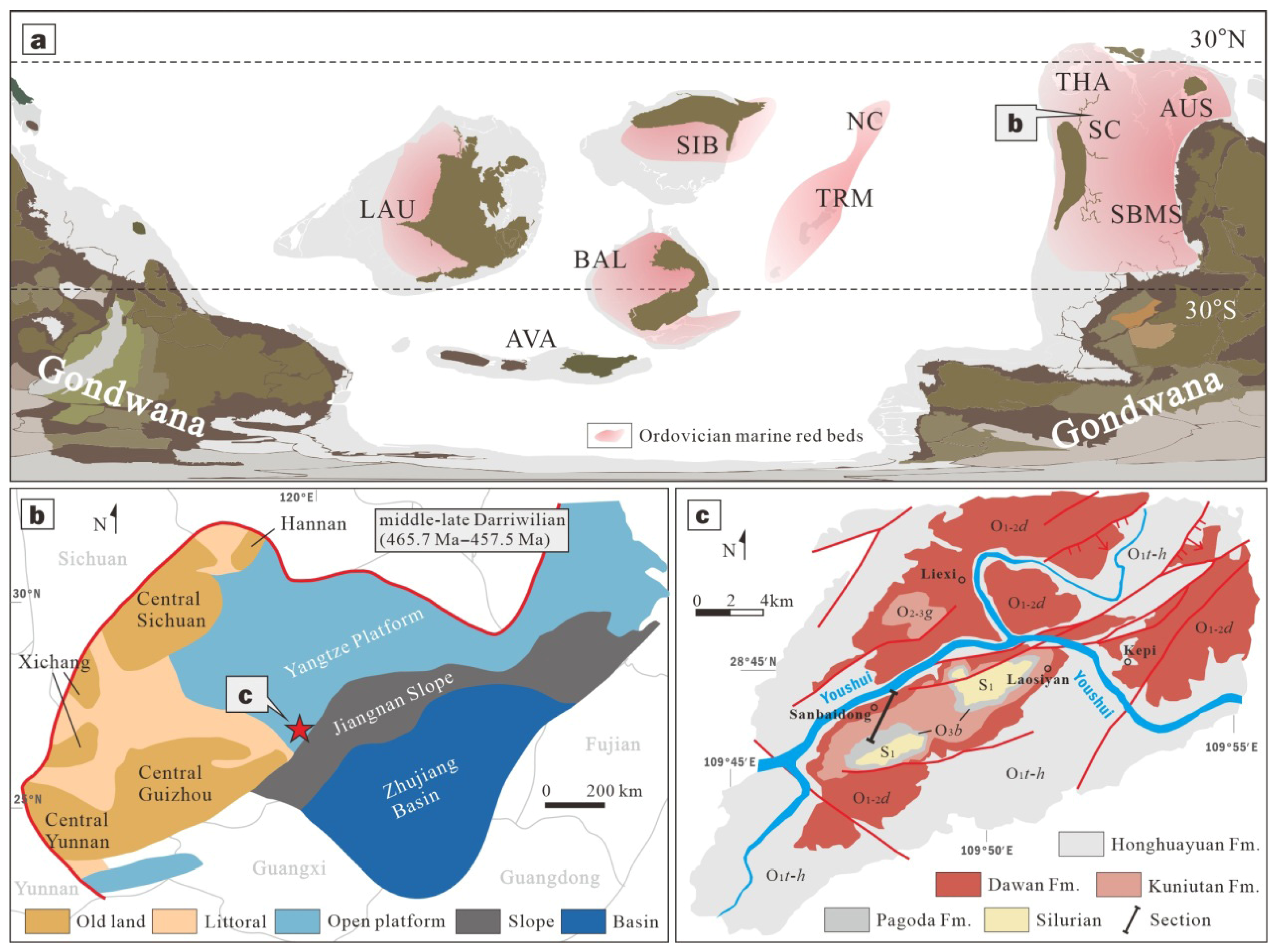
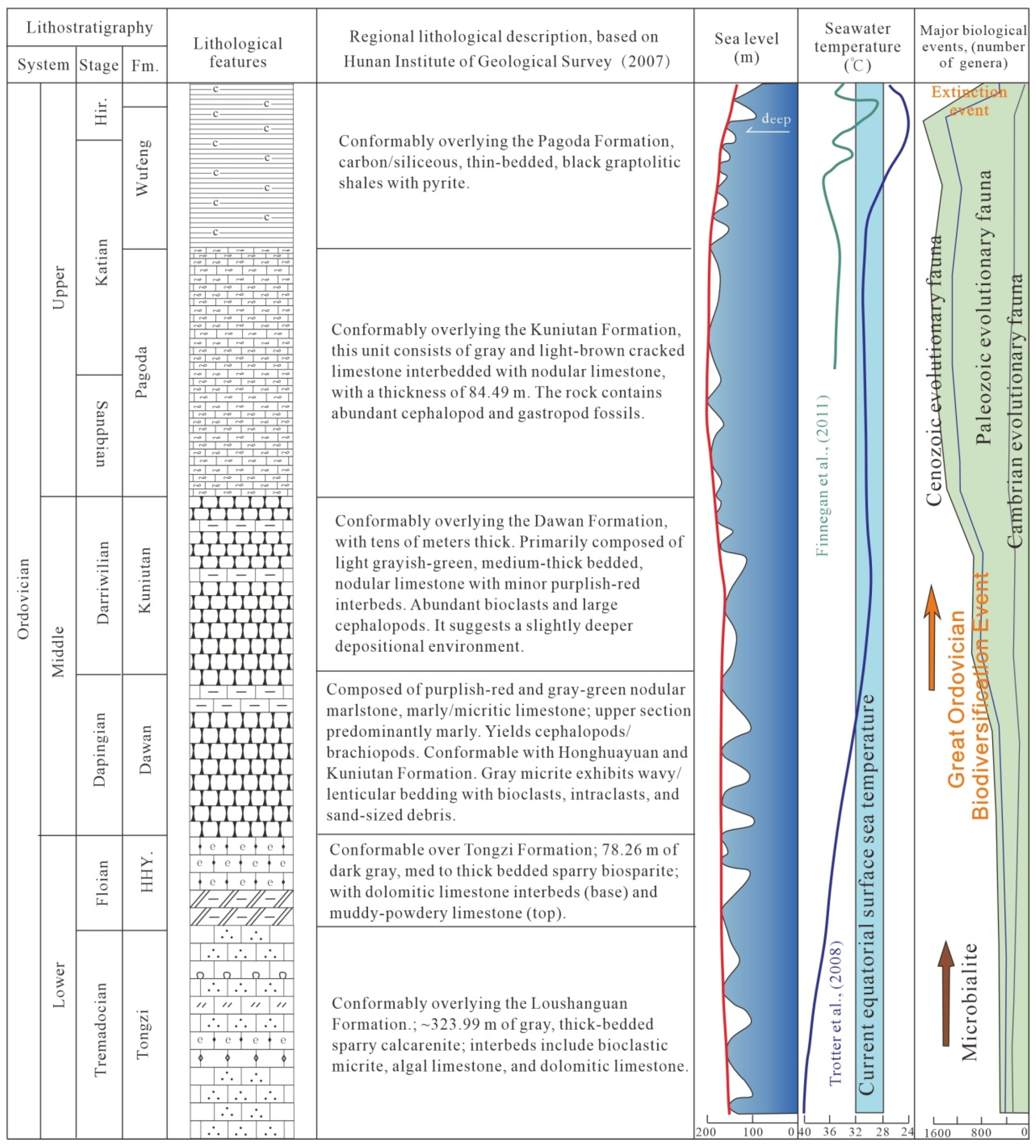

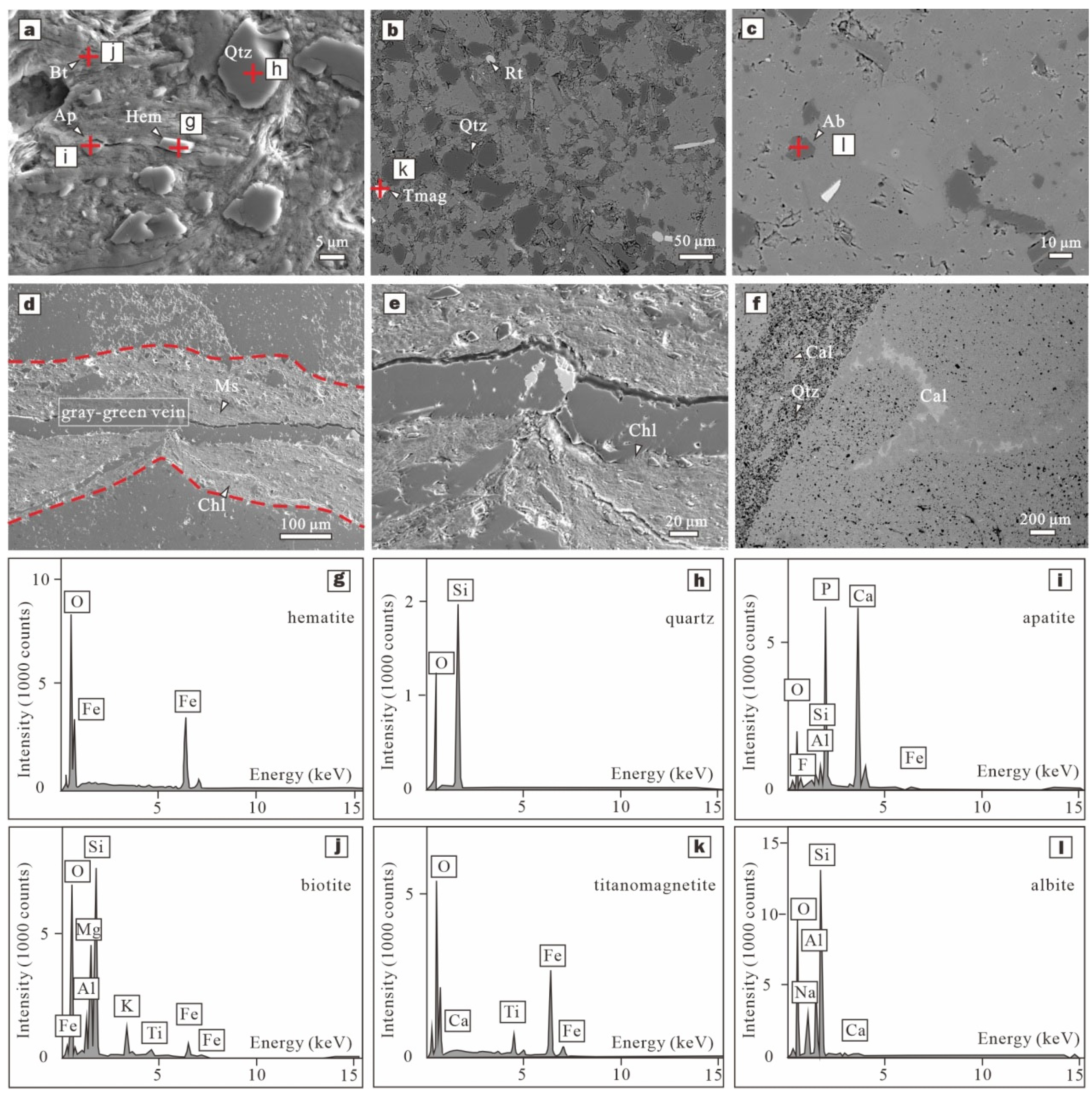
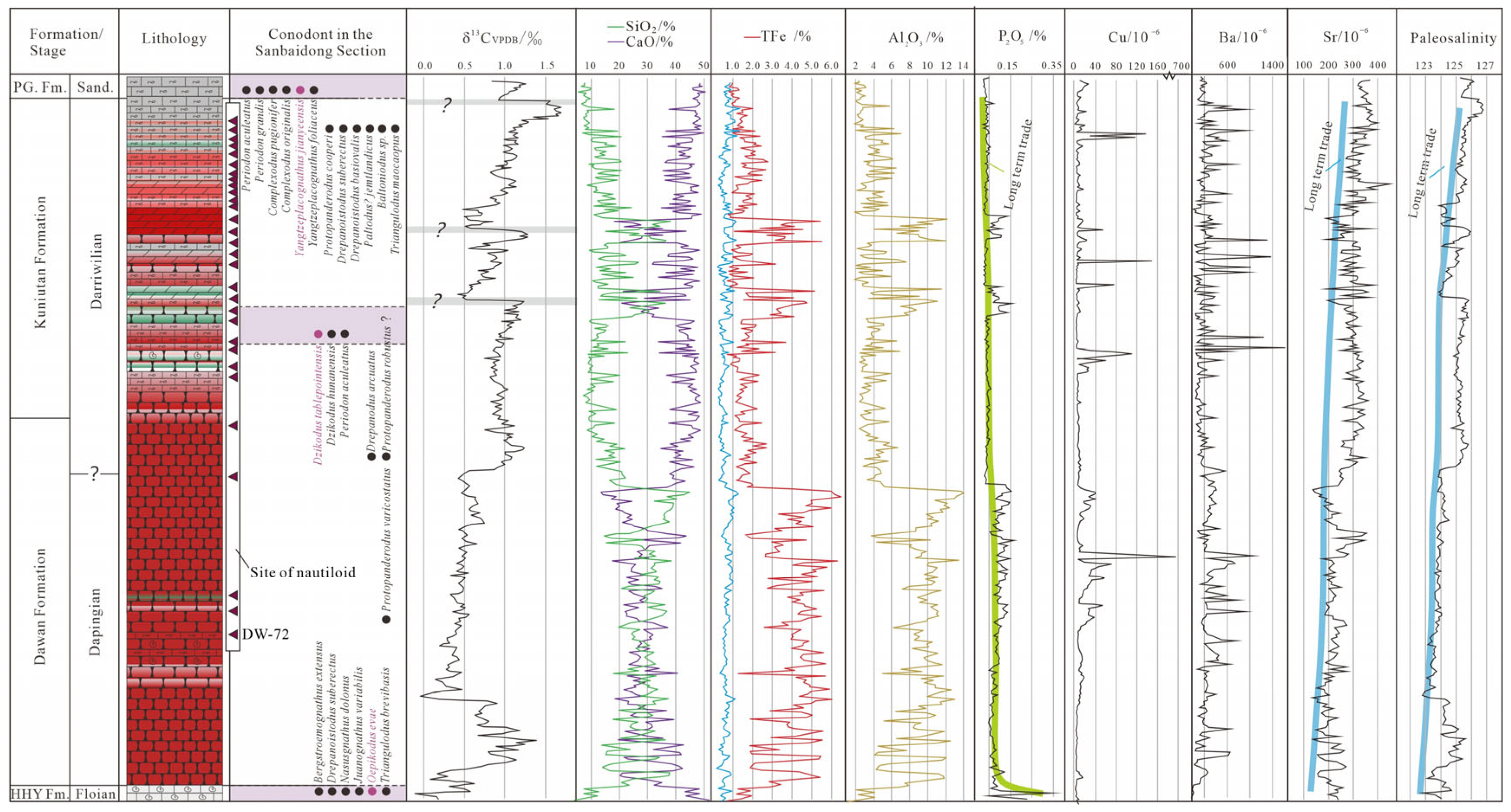
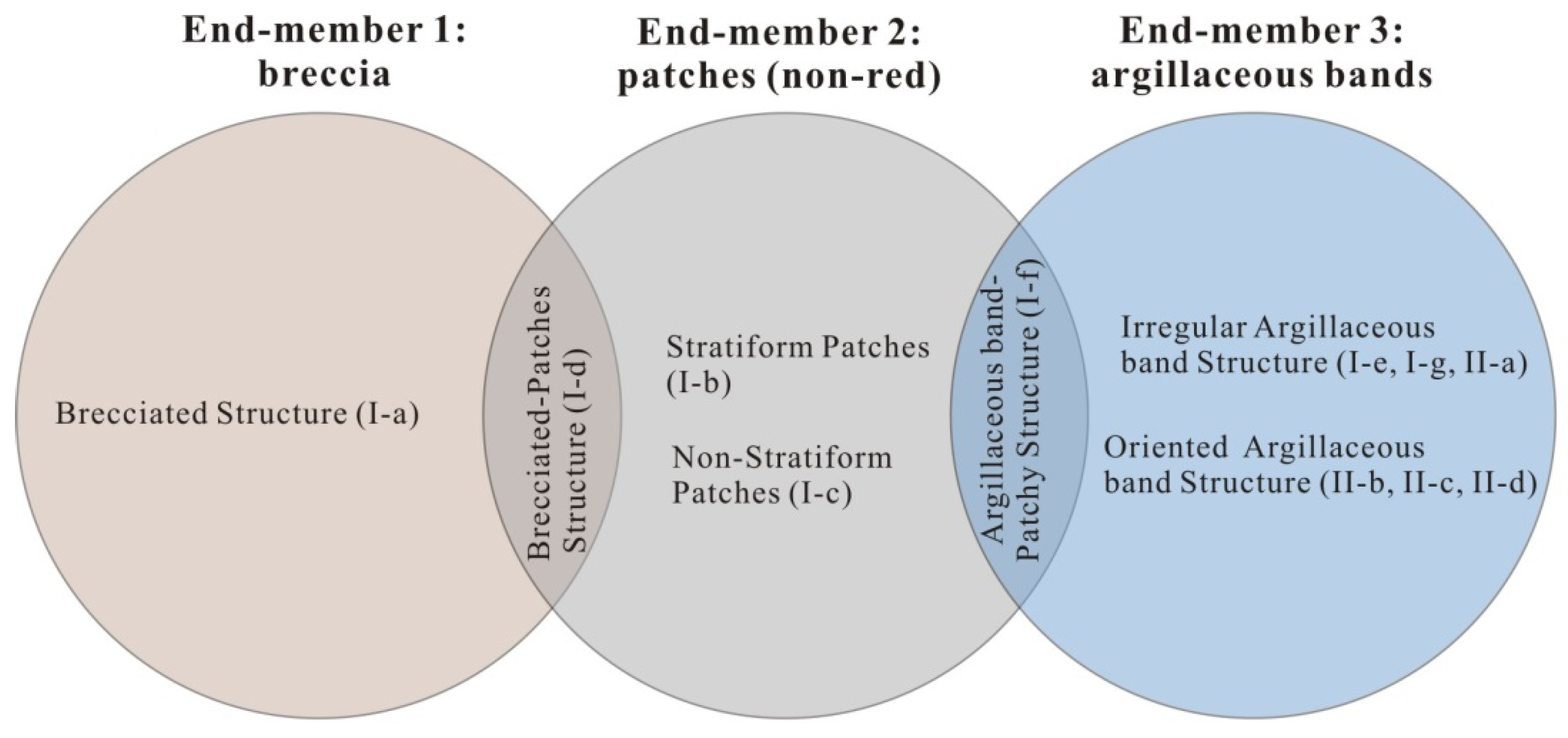

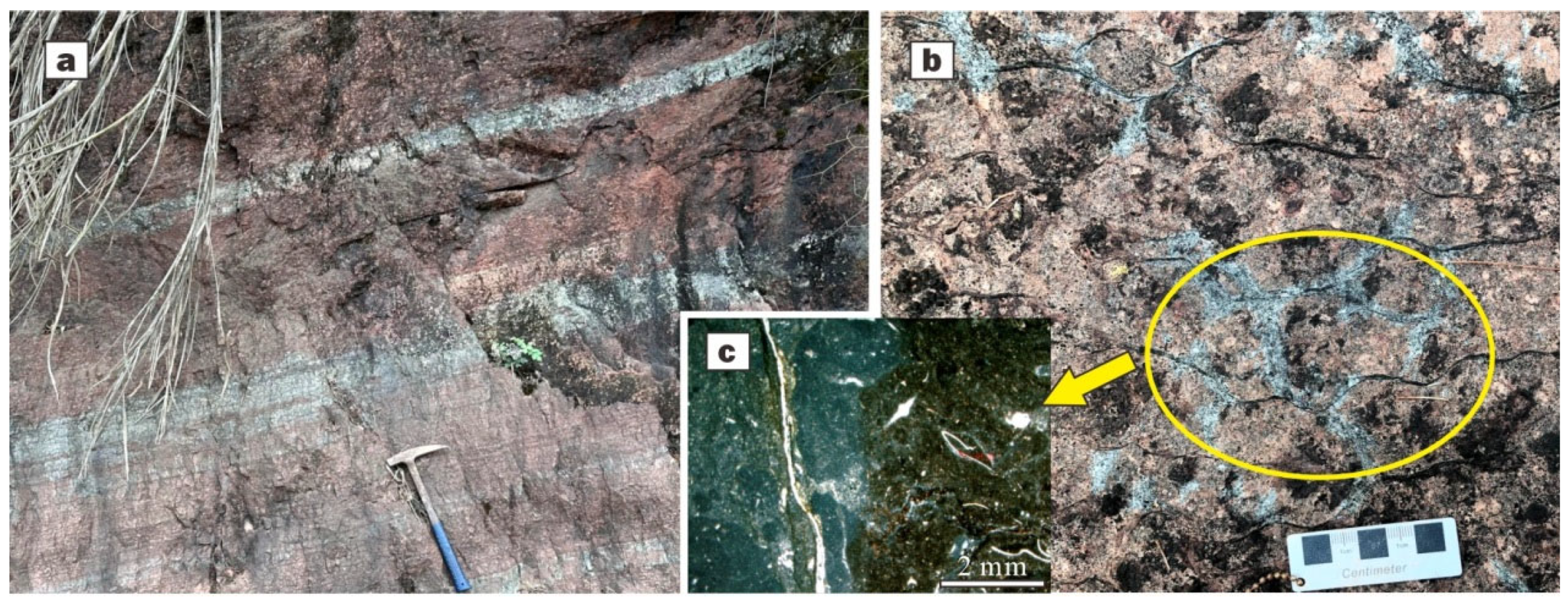


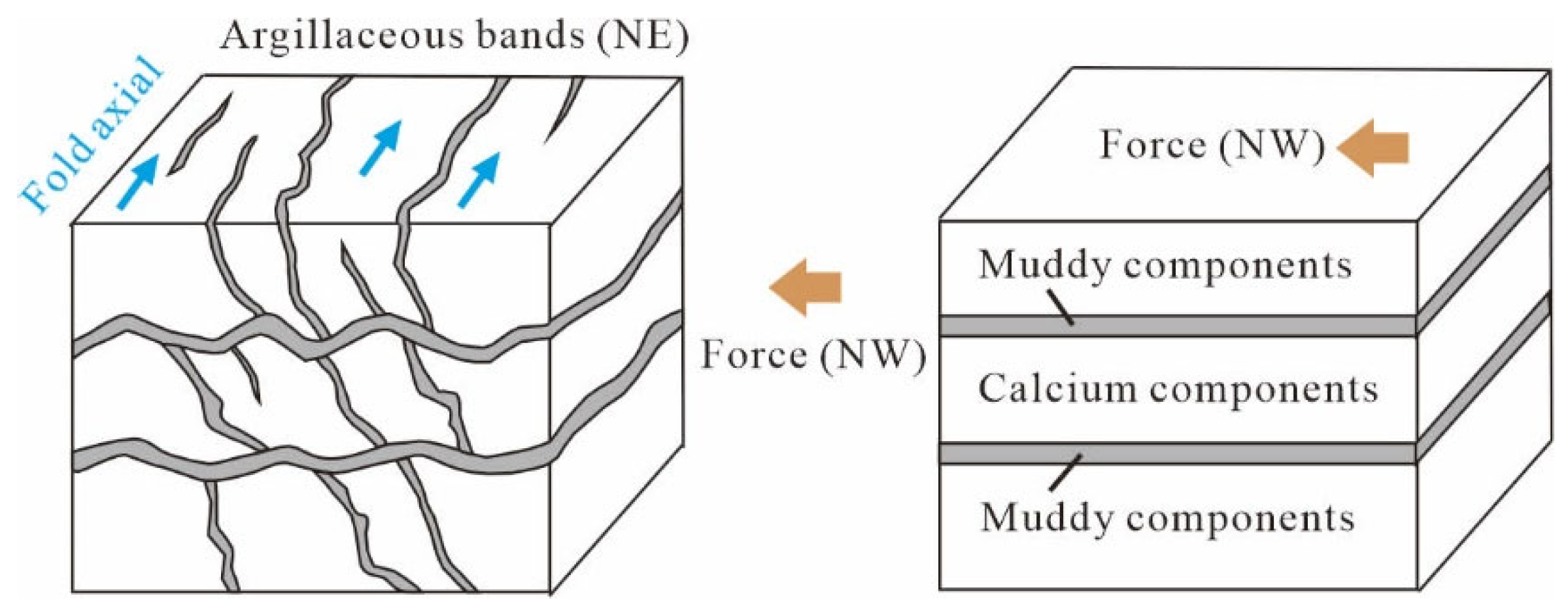
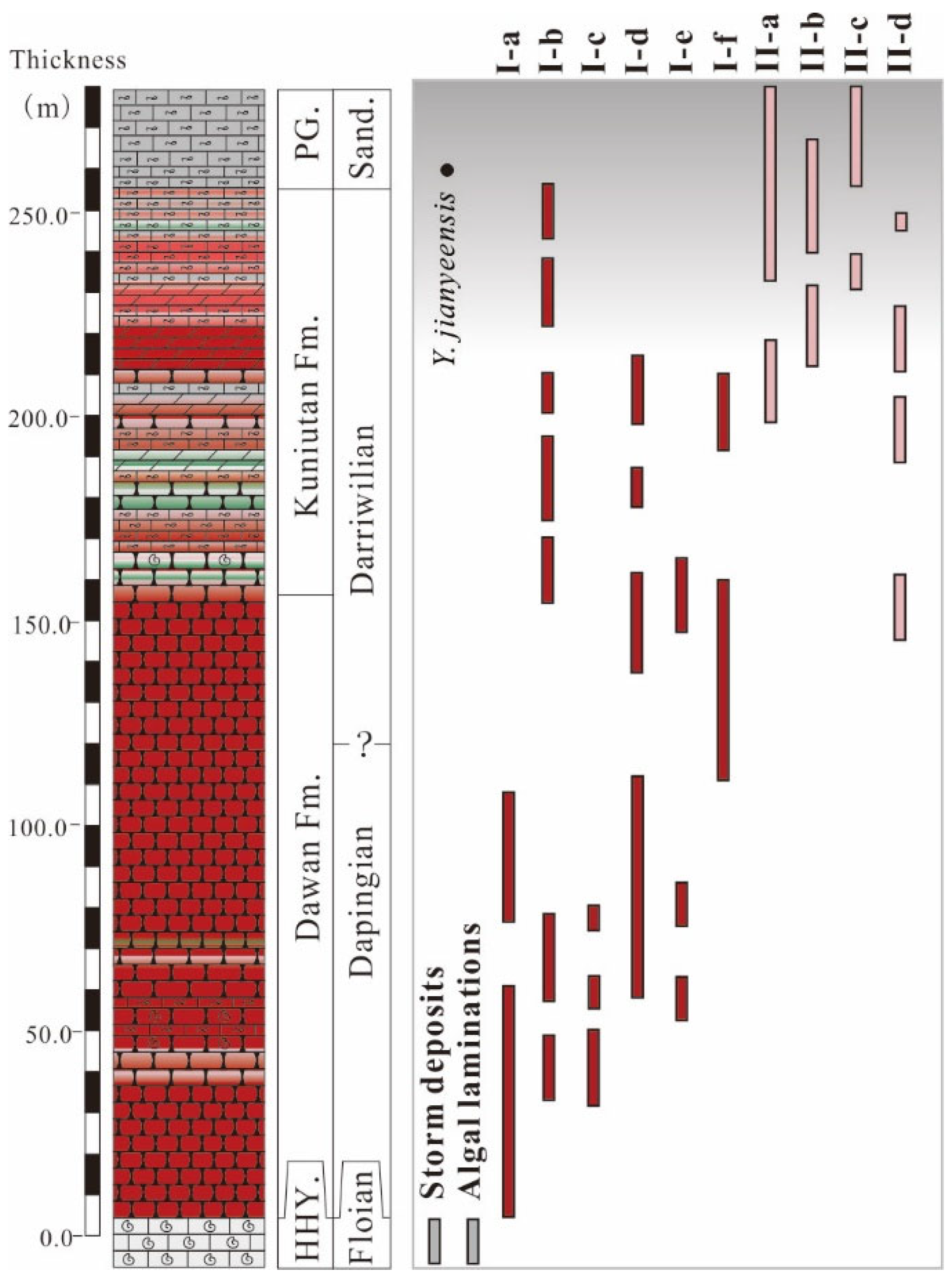
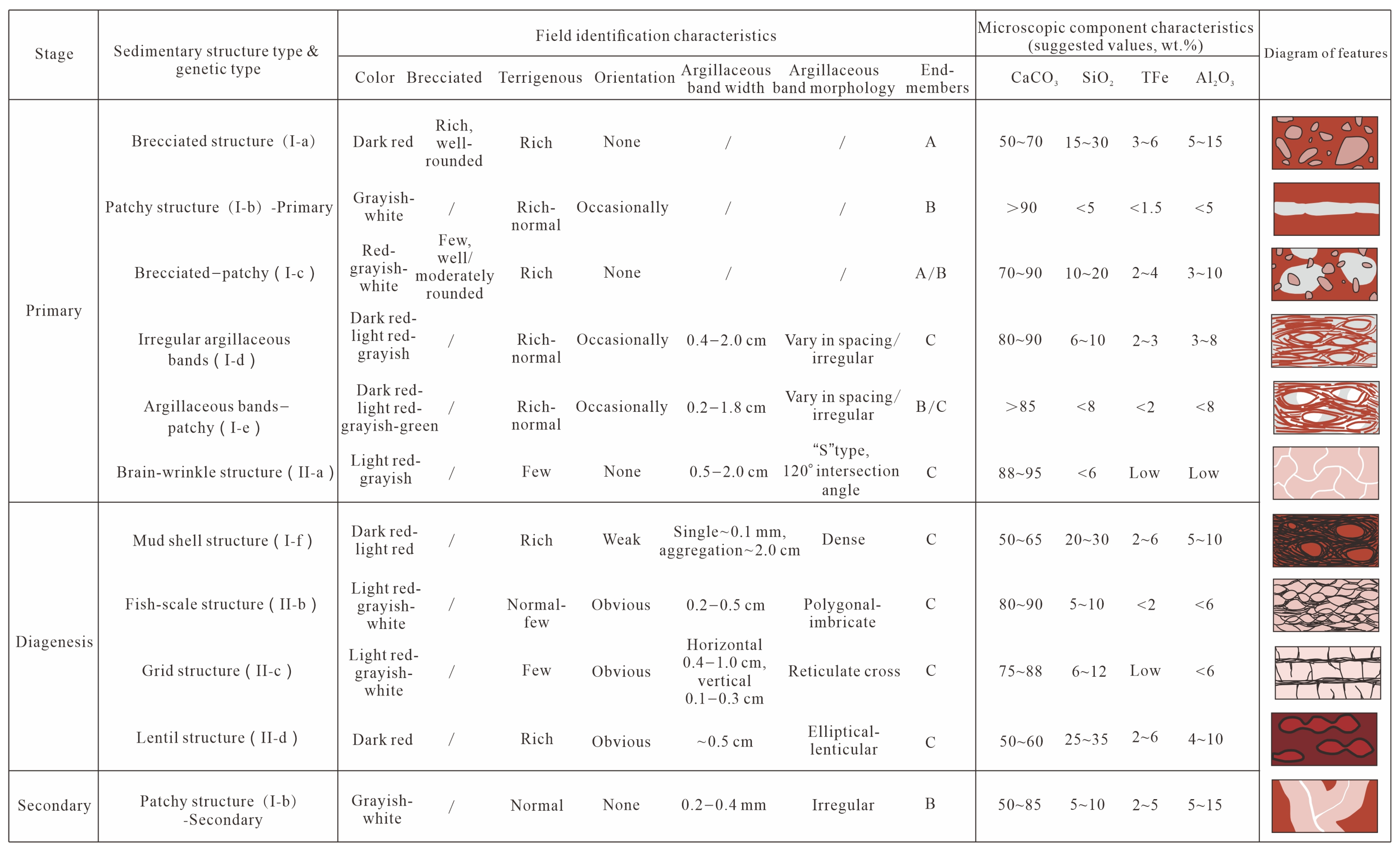
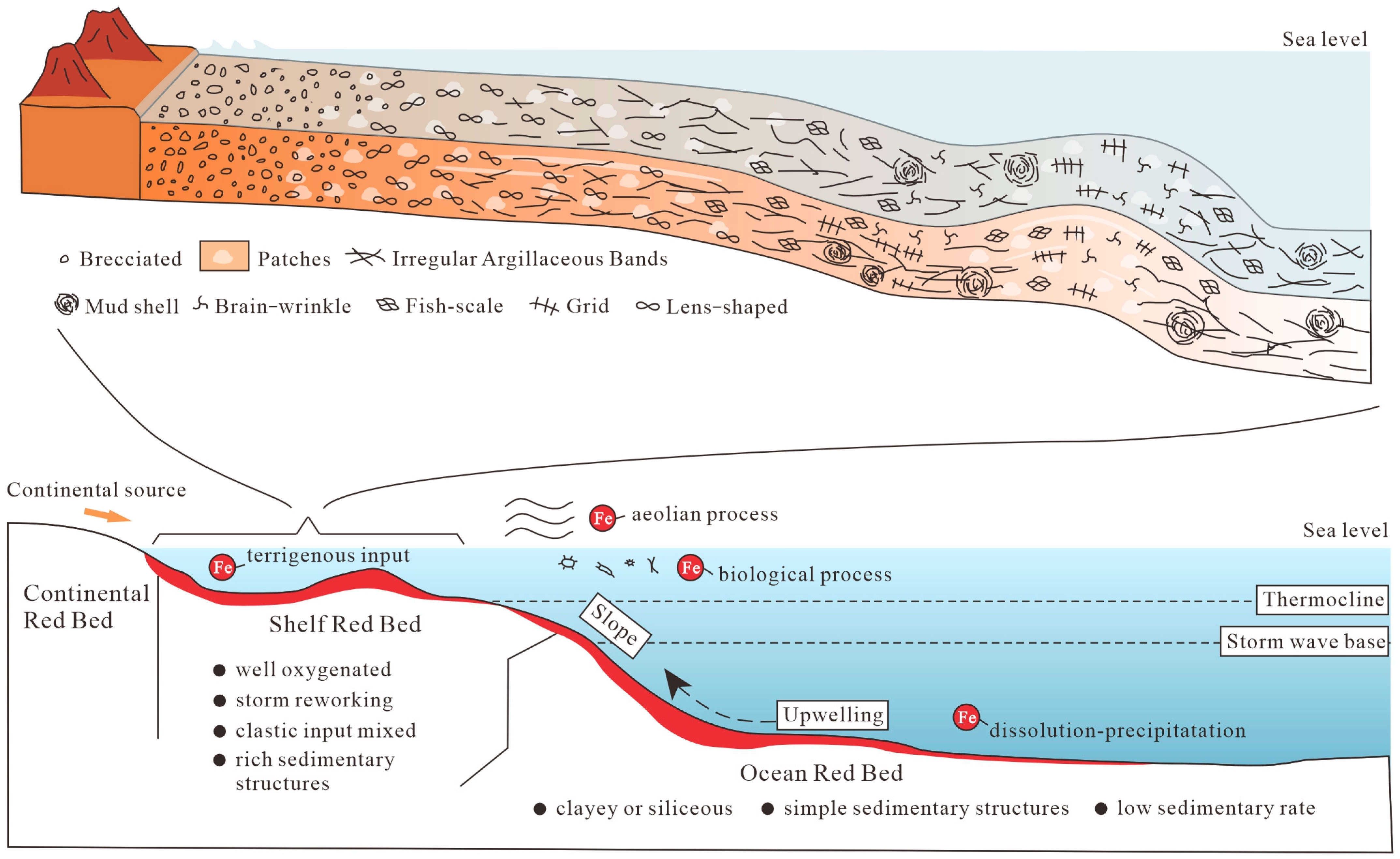
| Region | Stratigraphic Unit | Lithology | Estimated Age (Ma) | Sedimentation Rate (m/Ma) | References |
|---|---|---|---|---|---|
| Sichuan Basin, Well WX-2 | Wufeng Formation | Siliceous mudstone | Lasting ~0.73 | ~0.27 | [85] |
| Sichuan Basin, Qijiang | Wufeng Formation | Carbonaceous shale, marlite | 445.2~440.8 | ~0.69 | [86] |
| Hunan, Daming | Shizipu + Pagoda Formation | Bioclastic limestone | Lasting ~30 | ~2.66 | [70] |
| Sichuan Basin, Qiaoting | Pagoda Formation | Micritic nodular/vein limestone | Lasting ~4.17 (astronomical cycles) | ~7.67 | [84] |
| Sichuan Basin, Liangcun | Pagoda Formation | Same as above | Lasting ~5.64 (astronomical cycles) | ~6.37 | [84] |
| Sichuan Basin, Sanquan | Pagoda Formation | Same as above | Lasting ~5.05 (astronomical cycles) | ~4.68 | [84] |
| Hunan, Sanbaidong | Kuniutan Formation | Nodular limestone, etc. | 469.4~458.2 (conodont fossils) | ~9.02 | This study |
| Hunan, Sanbaidong | Dawan Formation | Nodular limestone, etc. | 471.3~469.4 conodont fossils) | ~80.5 | |
| Hunan, Yongshun | Nanjingguan-Fenxiang | Bioclastic limestone | Lasting ~7 | ~46.8 | [70] |
| Previous Studies’ Descriptions | Subtypes in This Study | Key Genetic Elements |
|---|---|---|
| “Nodular” | Brecciated structure (I-a) | Strong hydrodynamics, shallow water environment |
| Patchy structure (I-b) | 1. Short-term reducing environment; 2. Reducing fluid | |
| Brecciated–patchy structure (I-c) | Transitional type between I-a and I-b | |
| Irregular argillaceous bands (I-d) | Sloping environment during deposition, Compaction and pressure dissolution | |
| Argillaceous band–patchy structure (I-e) | Transitional type between I-b and I-d | |
| Mud shell structure (I-f) | High argillaceous content, Compaction and pressure dissolution, compressive stress | |
| “Cracked” | Brain-wrinkle structure (II-a) | Structural quiescence, quiet water, no slope |
| Fish-scale structure (II-b) | Similarly to II-a but with regional compressive stress | |
| Grid structure (II-c) | Alternating lime-mud deposition, modified by regional compressive stress | |
| Lens-shaped structure (II-d) | Turbid, rich in terrigenous material |
Disclaimer/Publisher’s Note: The statements, opinions and data contained in all publications are solely those of the individual author(s) and contributor(s) and not of MDPI and/or the editor(s). MDPI and/or the editor(s) disclaim responsibility for any injury to people or property resulting from any ideas, methods, instructions or products referred to in the content. |
© 2025 by the authors. Licensee MDPI, Basel, Switzerland. This article is an open access article distributed under the terms and conditions of the Creative Commons Attribution (CC BY) license (https://creativecommons.org/licenses/by/4.0/).
Share and Cite
Wu, L.; Quan, X.; Zhang, Y.; Wang, P.; Huang, C. A Shallow Water Case of Ordovician Marine Red Beds (South China): Evidence from Sedimentary Structures and Response to the Kwangsian Orogeny. Geosciences 2025, 15, 394. https://doi.org/10.3390/geosciences15100394
Wu L, Quan X, Zhang Y, Wang P, Huang C. A Shallow Water Case of Ordovician Marine Red Beds (South China): Evidence from Sedimentary Structures and Response to the Kwangsian Orogeny. Geosciences. 2025; 15(10):394. https://doi.org/10.3390/geosciences15100394
Chicago/Turabian StyleWu, Liangjun, Xiqiang Quan, Yuanhai Zhang, Pujun Wang, and Chao Huang. 2025. "A Shallow Water Case of Ordovician Marine Red Beds (South China): Evidence from Sedimentary Structures and Response to the Kwangsian Orogeny" Geosciences 15, no. 10: 394. https://doi.org/10.3390/geosciences15100394
APA StyleWu, L., Quan, X., Zhang, Y., Wang, P., & Huang, C. (2025). A Shallow Water Case of Ordovician Marine Red Beds (South China): Evidence from Sedimentary Structures and Response to the Kwangsian Orogeny. Geosciences, 15(10), 394. https://doi.org/10.3390/geosciences15100394






